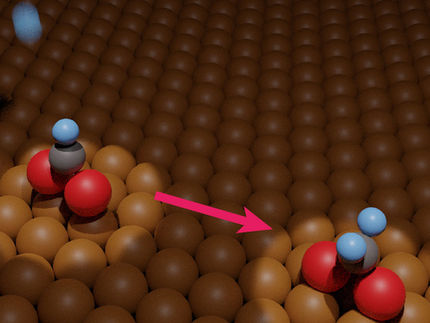Researchers plan to utilize greenhouse gas CO2with solar energy
In the project “Solar2fuel”, universities and companies are cooperating in developing alternatives to storage
Utilizing carbon dioxide as an energy source with the aid of sunlight is the goal being pursued in a new research project for recycling of greenhouse gases. Researchers from BASF, Energie Baden-Württemberg AG (EnBW), Heidelberg University and Karlsruhe Institute of Technology (KIT) are seeking to convert CO2 into a fuel for fuel cells or retrofitted internal combustion engines – a step towards implementing environmentally conscious mobility technologies and simultaneously an alternative to existing carbon dioxide storage plans.
The Verbund project “Solar2fuel” belongs to the “Forum Organic Electronics” excellence cluster and is being sponsored by the Federal Ministry of Education and Research (BMBF) with more than €1 million over two years.
While public discussion has so far centered mainly on the underground storage of carbon dioxide, the “Solar2fuel” project is focusing on the direct utilization of carbon dioxide. In this project, the carbon in carbon dioxide is converted into climate neutral fuels with the aid of sunlight.
“A photocatalytic process of this nature could open up new ways of generating easy-to-handle energy sources,” says Prof. Dr. Michael Grunze of the Physical-Chemical Institute of Heidelberg University. The aim is to combine approaches based on nanotechnology and material research with catalytic processes. The scientists at Heidelberg University are cooperating with BASF experts headed by Dr. Jan Schoeneboom to develop an air and light stable combination of dyes and functionalized nanoscale semiconductor particles.
Under these conditions, sunlight can be absorbed in the optimal range with the aid of organic dyes and supply energy for the conversion of carbon dioxide. Photocatalysis is therefore used to convert the carbon dioxide – generated for example by combustion processes in a power plant – together with water into the energy source methanol. In this way, sunlight can be used directly as a regenerative energy source in the recycling of CO2 – a process not unlike plant photosynthesis but, the researchers hope, much more efficient.
The experts at EnBW are investigating the energy, emission and cost balances of the overall process – from the power plant waste gas through the actual photocatalysis up to the utilization of the products. The cost of supplying carbon dioxide from power stations is also being analyzed.
The technical engineering aspects of “Solar2fuel” are being implemented by KIT scientists under the supervision of Prof. Dr. Henning Bockhorn. These experts are investigating the physicochemical and process technology aspects within the overall process. Based on an analysis of the overall system, the design of a photochemical reactor is to be developed and simulated using computer assisted methods.
In the “Forum Organic Electronics” excellence cluster sponsored by the Federal Ministry of Education and Research, university and nonuniversity research institutes are cooperating with industry in pursuing future-oriented developments in the field of organic electronics. Activities relating to the “Solar2fuel” project commenced in October of last year, BASF serves as coordinator for the consortium.
Other news from the department science
Most read news
More news from our other portals
See the theme worlds for related content
Topic world Synthesis
Chemical synthesis is at the heart of modern chemistry and enables the targeted production of molecules with specific properties. By combining starting materials in defined reaction conditions, chemists can create a wide range of compounds, from simple molecules to complex active ingredients.

Topic world Synthesis
Chemical synthesis is at the heart of modern chemistry and enables the targeted production of molecules with specific properties. By combining starting materials in defined reaction conditions, chemists can create a wide range of compounds, from simple molecules to complex active ingredients.





























































